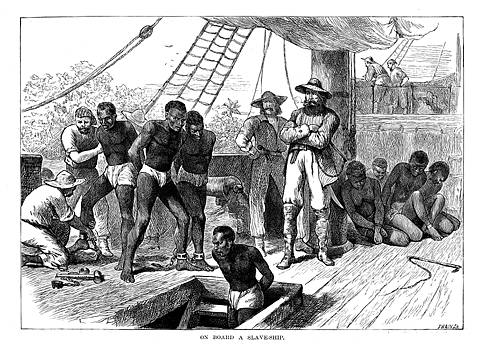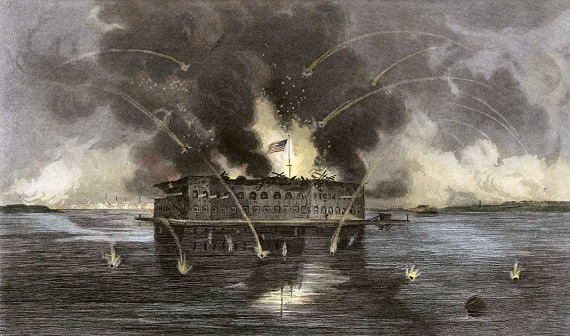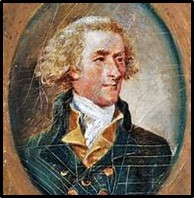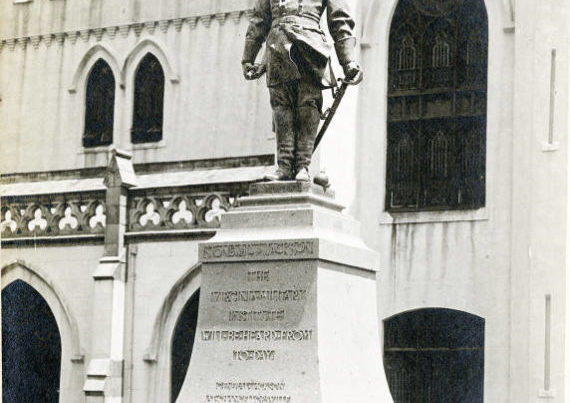The following remarks were delivered at the fourth annual Jefferson Davis Conference at Mount Crawford, Virginia on June 27, 2024.
When we hear about slavery, what do we hear about it? We hear that it was invented by white people when they enslaved black people. Actually, slavery has been in the world since the beginning of recorded history.
Historian John Steele Gordon has stated that from time immemorial, “slaves were seen as a major item of commerce…As much as a third of the population of the ancient world was enslaved.” Slavery was practiced in ancient Mesopotamia, Egypt, Greece, and Rome. Aristotle considered it “natural” and Plato’s Republic was not only supported by, but founded on it. Slavery existed in India at the time of Buddha and in China as early as the 17th Century BC.
English author Simon Webb has noted that at the time of the Norman Conquest in 1066, Bristol, England was already an international center of slave trade under the Anglo-Saxons, “that of exporting English slaves to Ireland and, from there, to Africa and Scandinavia.” He says that a tenth of the people in England were slaves at that time. The Vikings were involved in the slave trade, which is why some English slaves went to Scandinavia. Dublin, Ireland was founded by the Vikings in 841 AD “and its prosperity and growth were closely bound up with the slave trade.” The Vikings regularly raided European coasts and enslaved their inhabitants.
Note that I mentioned export of English slaves to Africa. As I mentioned at the beginning, we only hear today of things being the other way around. In the teachings of Islam, both the Qu’ran and the Hadith regulate slavery and treat it as a part of life. Enslaving freeborn Muslims was prohibited, so those enslaved by Muslims were non-Muslims. Beginning in the 9th Century, Muslims acquired slaves from countries bordering North Africa, the Middle East, and Persia, which they held. Beginning at that time, Islam sought to expand its domain from Saudi Arabia, where it began. At its height, it conquered north into Turkey and the Balkans, east into India, and west into North Africa and Spain. Most of the important slave markets were in Arab cities and most of the raiders who captured and enslaved people were Arabs. As Turks and Indians embraced Islam, not many of them were enslaved.
The Muslims went in all directions from the territories they held to acquire slaves. Going south from North Africa, there was already a market. There were two main black peoples in Africa, the Bantu and the pygmies. The Bantu were mostly agricultural and the pygmies were mostly hunters. Consequently, the Bantu conquered most of the territory in Sub-Saharan Africa and enslaved the pygmies. Another factor to consider in Africa is tribalism. Among indigenous black people in Africa, it was the tribe and not the black race that was of utmost importance in their identity. When tribes went to war with other tribes, they would enslave the members of the tribe which they had conquered or who they had captured. The Africans also sold them on the frontiers of the Islamic empire. The Muslims sold these slaves not only within their own borders, but also in India and across the Mediterranean.
The Muslims signed a treaty with Nubia whereby Nubia would provide slaves in exchange for peace. It was probably for this reason that Nubia was not taken over by the Muslims for a long time. As the Muslims opened up trade routes across the continent, religion, ideas, and slaves were transported across them. As they conquered south, the Arabs used the coast of the Zanj, which is modern Kenya and Tanzania, to transport slaves to the Middle East, where they were sold in cities such as Basra and Baghdad. Before Somalia was Islamized, large numbers of Somali slaves were exported from the Somali coast to Mecca and from there to Damascus and Baghdad. Mecca, considered the holiest city by Islam, was a major market for the slave trade. A large number of Zanj slaves were used on thousands of plantations and in salt peter mines in Mesopotamia. The conditions were so bad that slave revolts began there in 868 AD and continued for centuries. Ibn Khaldun said in the 14th Century that black slaves in North Africa constituted “the ordinary mass of slaves.” The Muslim Berbers of North Africa also conducted raids across Africa to enslave Africans. Some of these raids went into West Africa, all the way to the Atlantic. The trade went across the Indian Ocean to India and Indonesia.
One reason for the Muslim desire for slaves was as eunuchs who would guard harems. The Vikings sold Slavs from Eastern Europe to the Muslims as slaves. The word slave is derived from the word Slav because so many of them were enslaved. Castration had to be performed on these slaves in order to produce eunuchs. Few adults on which castration was performed survived, but there was a high survival rate among young boys on which this was performed. Castration houses were set up in such European cities as Verdun and Venice and young boys were sold to Muslims from there. Castration was never performed on black slaves in America except as a punishment for rape.
As the Islamic Empire moved into the Balkans, people from Greece, Albania, Armenia, and the Russian Steppes were enslaved. They would be sent to cities such as Baghdad for indoctrination and were required to learn and only speak Arabic. Simon Webb writes that:
“in the 1380s the system of devshirme was instigated. During the devshirme, a word meaning gathering or harvest, representatives of the sultan scoured Greece and the Balkans every five years, aiming to take healthy and intelligent boys between the ages of eight and 14, being taken from their families and carried off into slavery. They were taken to Constantinople, where they were circumcised and then converted to the Muslim faith. It will be observed once again, it was the Slavs who were victim of slave raids, for that is what the devshirme effectively was. The children were seized from the countries which make up modern-day Serbia, Bosnia, Croatia, Slovenia, Albania, Macedonia, Bulgaria, [Hungary, Georgia,] and Greece….Once they were in Constantinople, the boys gathered in the devshirme were educated and firmly assimilated into Turkish culture.”
As we have seen, the Muslims enslaved whites as well as blacks. Just as they went beyond their southern borders in Africa to enslave, they also did so beyond their northern borders in Europe. One means of doing this was carried out by the Barbary corsairs. The Barbary region of North Africa consisted of Morocco, Algiers, Tunis, and Tripoli, which today are Morocco, Algeria, Tunisia, and Libya. The corsairs were like a combination of privateers and pirates. They acted like pirates, but for their various countries in an official manner working with the military forces of the Ottoman Empire to transport these slaves. They attacked coastal towns in Europe, seized their inhabitants, and took them to North Africa, where they were sold into slavery. They were fed nothing but bread and water and many of them died both on the way to North Africa and after they arrived and worked there. In 1544, the corsairs began attacking islands which were off the coast of Italy and Sicily. 4,000 inhabitants of the island of Ischia were enslaved and 2,000 to 7,000 inhabitants of Lipari were also enslaved. The corsairs also attempted to colonize these islands to expand the Muslim empire into the Mediterranean, just as it was being expanded in Southeastern Europe at the same time.
Then they attacked towns along the Italian coast, taking most of their inhabitants, and from there, other towns all along the northern coast of the Mediterranean. They even went north of the Mediterranean into the waters of Northern Europe, enslaving Europeans as far away as the Netherlands, England, Ireland, and even Iceland and Newfoundland. Ships of European countries were also attacked. While the ship’s cargo was seized, they mainly wanted the crew and passengers for slaves.
The Pasha, or ruler of the country, was entitled to an eighth of the slaves. Those Europeans taken into slavery in North Africa were given various tasks. Women became house servants or concubines. Men could be assigned administrative duties or hard manual labor, such as heavy construction and working in quarries. At night, they were put in prisons called baginos, which were often hot and overcrowded. One of the assignments for men was that of galley slave. The slave would row the oars of the ship. These were huge oars and it would take several men to row each one. Galley slaves were permanently chained to their oars and never released. They had to learn to sleep sitting up and had to relieve themselves where they sat. They were sometimes ankle deep in human waste and it was said that you could smell these ships a mile away. An order of the Catholic Church called Our Lady of Mercy, also known as the Trinitarians, raised money to purchase the freedom of slaves in Barbary. The corsair ships were very agile and the slow ships of the European navies were no match for them, so they had free reign in the Mediterranean.
This was something which was once very well known. Mention of it is to be found in history books in years past. One example of how well this was once known is the motion picture The Sea Hawk which was released in 1924. It depicted the kidnapping and enslaving of an Englishman by Barbary corsairs on the coast of England and was based on a novel of the same title by Rafael Sabatini released in 1915. It should be noted that this is a totally different story from the one in the movie of the same title which was released in 1940. That one was set in the period of the Spanish Armada.
European countries also had galley ships and would sentence convicted criminals to row them. At the Battle of Lepanto in 1571, they defeated the Ottomans and freed 12,000 European galley slaves. In 1575, Miguel de Cervantes, while serving as a Spanish Marine, was in a ship which was attacked by corsairs and he and the others on board were taken to Algiers, where they were sold into slavery. His freedom was purchased five years later by the Trinitarians. He wrote of slavery in Barbary in his novel Don Quixote. Christopher Columbus was also captured and enslaved by Muslims, but escaped.
It should be noted that Muslim slaves were sold in Spain, France, and Italy, and that they were found among the galley slaves of the vessels of those countries.
After he won the English Civil War, Oliver Cromwell sent Robert Blake with a naval force to Tunis in 1655. Blake fought a successful naval engagement which resulted in the freedom of English slaves in Tunis and Algiers. However, English seamen continued to be seized for another 150 years, as were those of other European nations.
European countries ended up paying tribute to the Barbary states to purchase right of passage for their ships so that they would not be seized. They found this cheaper than taking military action. Sometimes, however, the Barbary states would seize ships from countries which had paid tribute in order to get them to pay more tribute. This became the state of affairs for some time.
Before the United States gained independence from Great Britain, colonial vessels sailed under the British flag and had the protection enjoyed by British tribute payments to the Barbary states. The United States Navy had been scrapped at the end of the Revolutionary War because it was thought there was no more need for it.
In 1785, two years after the end of the war, John Adams, who was then the US ambassador to Great Britain, was approached in London by an envoy from Tripoli. He proposed a treaty whereby US merchant vessels would not be harmed if the United States were to pay an annual tribute of $150,000, plus ten percent on top of that for himself for negotiating the deal. Annual tribute to all four of the Barbary states would have cost $600,000. Adams wanted to negotiate a tribute deal, but the United States Treasury did not have that much money. Thomas Jefferson, who was then the US ambassador to France, wanted to take military action. He proposed an alliance between the United States, Portugal, and Naples to take naval action in order to deal with the Barbary states, but that was not agreed to. As a result, beginning in 1785, Algerine corsairs seized US merchant vessels and sold their crews into slavery in North Africa. These actions left 105 Americans enslaved in Algiers. The British had encouraged them to do this in order to hurt US trade, which was now providing competition to British trade. The US did not have enough money to pay the tribute demanded. Moroccan corsairs then captured another US ship, but Morocco only demanded $10,000 to leave US shipping alone. This was agreed to and a treaty was signed and ratified by the US Congress in 1787.
Beginning in 1795, the United States paid Algiers an annual tribute of $21,000, and, in 1796, began to pay Tripoli an annual tribute of $56,000. When these payments were made, the US slaves were freed. However, the treatment of the slaves in the Barbary states was so cruel that one third of them did not survive. Thus, the United States was now doing what all of the large European nations were doing.
President George Washington saw that there was a need for a navy to take action against the Barbary corsairs and got Congress to start building one. He did not want the business of paying tribute to protect commerce and free slaves to continue. In 1800, at the close of the Quasi-War with France, Algiers began demanding $200,000 a year and Tripoli $250,000 a year. The new President, Thomas Jefferson, did not wish to give in to these demands. In 1801, he sent the US Navy to the Mediterranean, resulting in the First Barbary War. At the war’s end in 1805, US Naval and Marine Corps power brought about a treaty which included payment for ransom of slaves, but not for annual tribute.
This did not stop the Barbary corsairs from continuing to seize US ships, but troubles with Great Britain which resulted in the War of 1812 were a bigger priority. During that time, tribute to Algiers had resumed because of the troubles. Following the conclusion of that war in 1815, President James Madison decided to take action again, resulting in the Second Barbary War. The US Navy was much larger then after the War of 1812. After the US fleet leveled Algiers, the Pasha sued for peace. All slaves were freed and no more tribute was demanded. Similar treaties were then negotiated with Tunis and Tripoli.
Once the US fleet was gone, however, the Pasha of Algiers demanded to reinstate the former treaty with tribute payments. After seeing US results, the British and Dutch fleets joined the US fleet in going to Algiers, so this time it was an international force. Once again, the Pasha backed down. After the European powers saw that the Barbary states were subdued in this way, France took Algiers in 1830. This put an end to the Barbary corsairs and their enslavement of whites. France later took Tunis in 1881.
However, this did not put an end to Muslim slave trading. While Great Britain and the United States put an end to the Atlantic slave trade on the west coast of Africa in the 19th Century, the Muslims still continued the slave trade on the East Coast of Africa, and this was in black African slaves. It was not until the European powers colonized Africa that this slave trade came to an end. But it continued in the Middle East. There, the slave trade did not end until 1950 and Saudi Arabia did not outlaw slavery until 1962. Mauritania, the last Muslim nation and last of all nations to officially abolish slavery, did so in 1981.
The Trans-Atlantic African slave trade is the one which gets the most attention. However, an estimated 12 million African slaves were traded to the Americas from 1450 to 1850. And less than ten percent of the African slaves who came to the Americas came to the mainland of North and South America. Over 90 percent went to the Caribbean. The reason for this is because, in many areas of the Caribbean, slaves were not fed or clothed. They were worked until they died and then new slaves were purchased. The average life span of a slave in these areas was four months. This was done because it was cheaper than the cost of feeding and clothing them. In contrast, the average life span of a slave in the United States was 30 years.
The Muslim slave trade existed for much longer, and it is estimated that 17 million slaves were traded by them from 600 AD to 1900, and that does not include the ones traded in the 20th Century. Even today, there are still slaves in Sub-Saharan Africa, where slavery is now taking the form of child soldiering, human trafficking, and forced labor. The lowest estimate is that there are currently 700,000 such black slaves in this region.
The State Department 2024 Trafficking in Persons Report says that there are currently 27 million people worldwide who are enslaved under human trafficking. Indeed, two of these forms of slavery, human trafficking and forced labor, are even practiced here in the United States today, though illegally.
It is ironic that there are those who say there were no black Confederates, but at the same time se nothing wrong with the fact that there are black Muslims. Those who point out the fact that there were black Confederates are accused of justifying slavery, but those pointing out the facts about Muslim slavery are called “Islamophobic.” Of course, the reason for this duplicity is to promote the “woke” Marxist agenda.
Sources:
Simon Webb, The Forgotten Slave Trade: The White European Slaves of Islam. Pen & Sword History, Yorkshire, UK: Pen & Sword Books Ltd, 2021.
Robert C. Davis, Christian Slaves, Muslim Masters: White Slavery in the Mediterranean, the Barbary Coast, and Italy, 1500-1800. Early Modern History: Society and Culture Series, New York: Palgrave Macmillan, 2003.
Paul Baepler, ed., White Slaves, African Masters: An Anthology of American Barbary Captivity Narratives. Chicago: University of Chicago Press, 1999.
Dudley W. Knox, A History of the United States Navy. New York: G.P. Putnam’s Sons, 1936.
Theodore Roscoe, This is Your Navy: An Informal History. Annapolis: United States Navy League, 1950.
Kenneth J. Hagan, This People’s Navy: The Making of American Sea Power. New York: Free Press, 1991.
Craig L. Symonds, The U.S. Navy: A Concise History. New York: Oxford University Press, 2016.
The Sea Hawk. Directed by Frank Lloyd. Frank Lloyd Productions, 1924.
U.S. Department of State, Federal Response on Human Trafficking
www.state.gov/humantrafficking
U.S. Department of Defense, Combating Trafficking in Persons
U.S. Department of Homeland Security, Blue Campaign







“It is ironic that there are those who say…”
Irony is the soul and breath of these people. They look in the rearview mirror and see themselves and believe that God is behind them.
Harper’s Weekly, 10 Jan 1863, Rebel Negro Picket…begs to differ.
This is an excellent informative article. I do wonder about one thing that is not related to the info in the article. At the risk of insulting Mr. Duskin, I feel compelled to point out that “Northern Virginia” is not a place. It isn’t like Richmond or Roanoke or Lexington of Luray. It is a vast Census designated, amorphous area where it literally takes an hour to travel 10 miles most of the time. It is LA with fewer 4 lane highways. It is Calee without the weather. It is simply awful. It is filled with rootless transplants all of who are connected directly or indirectly with D.C. IMO, it is a Hellscape. I don’t grasp the idea of being from there. Having once lived in Fairfax County many decades ago, ‘Northern Virginia” has lost all of its attributes of being part of the South. Places linked to the South like Fairfax City, McLean, Alexandria etc. still exist but they are Yankee-fied. NOVA, as it is derisively known, is a rootless, soulless ever metastasizing tumor of humanity jammed into the region with “No there, there”. My instincts, and for the sake of Southerners without knowledge of the region, tell me everyone needs to know these facts – but I can’t explain why I feel so strongly that everyone needs to know all this.
I apologize Mr. Duskin. I hope you will accept it.
Been to SE Va lately (Hampton Roads)? They’re packing in all the people they can, here, too. It’s choked with traffic. They’re building a little city in/near what was the quaint town of Poquoson. Magruder Blvd in Hampton has been changed to Neil Armstrong Parkway. There’s a street named after Nat Turner in Newport News. The Jefferson Davis memorial at Ft. Monroe has been removed. A school in Hampton was named after him, but that’s been changed. I’m surprised there’s still a monument to the Confederate soldier at a church in downtown Hampton. Tappahannock is a couple of hours away, but a very handsome monument to the Confederate soldier was removed in the last year, year and a half. There’s a nice Confederate monument in Lancaster, Va. I don’t know if there are plans to mess with that yet. It’s sad, but whoever are Christian’s around here, they need to realize or remember what else is going on. This whole world is on a “course.” Like Jeb Stuart and R.E. Lee, one needs to make sure they’re not on that course.
Really sad to hear all that, but thanks for the info Matt. It’s always good to be informed.
I didn’t mention beautiful Smithfield, Suffolk, Isle of Wight/Carrollton. Over developed, imo, cookie cutter residences/apartments all over the place. Has changed unbelievably in the last 40 years. I don’t know who is going to live in these places. Makes me wonder if it’s about having all the eggs in one basket. Deeper in Smithfield south and northwest toward Petersburg, is still spectacularly rural. I just heard this today, well, I’ve heard it before, but a Bible teacher was saying that when the Lord brings His church up, He’s going to have to pry some folks hands from off the earth because they’re so dug in deep and attached. It’s something for the Christian to think about and remember. There’s something a whole lot bigger ahead. In James I. Robertson’s biography of Stonewall, I think it was in the introduction, but Robertson was talking about how Stonewall looked at things, a little bit more at the things, unseen. I liked and appreciated that part (and the whole book).